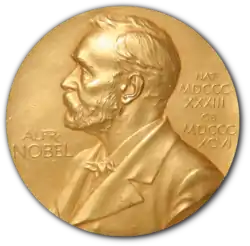Carl David Anderson
Carl David Anderson (September 3, 1905 – January 11, 1991) was an American physicist. He is best known for his discovery of the positron in 1932, an achievement for which he received the 1936 Nobel Prize in Physics, and of the muon in 1936.
Carl David Anderson | |
|---|---|
 Anderson in 1936 | |
| Born | September 3, 1905 New York City, New York, U.S. |
| Died | January 11, 1991 (aged 85) San Marino, California, U.S. |
| Alma mater | California Institute of Technology (B.S. and Ph.D) |
| Known for | Discovery of the positron Discovery of the muon |
| Awards | Nobel Prize in Physics (1936) Elliott Cresson Medal (1937) |
| Scientific career | |
| Fields | Physics |
| Institutions | California Institute of Technology |
| Thesis | Space-distribution of x-ray photoelectrons ejected from the K and L atomic energy-levels (1930) |
| Doctoral advisor | Robert A. Millikan |
| Other academic advisors | William Smythe |
| Doctoral students | |
| Other notable students | Cinna Lomnitz |
Biography
Anderson was born in New York City, the son of Swedish immigrants. He studied physics and engineering at Caltech (B.S., 1927; Ph.D., 1930). Under the supervision of Robert A. Millikan, he began investigations into cosmic rays during the course of which he encountered unexpected particle tracks in his (modern versions now commonly referred to as an Anderson) cloud chamber photographs that he correctly interpreted as having been created by a particle with the same mass as the electron, but with opposite electrical charge. This discovery, announced in 1932 and later confirmed by others, validated Paul Dirac's theoretical prediction of the existence of the positron. Anderson first detected the particles in cosmic rays. He then produced more conclusive proof by shooting gamma rays produced by the natural radioactive nuclide ThC'' (208Tl)[1] into other materials, resulting in the creation of positron-electron pairs. For this work, Anderson shared the 1936 Nobel Prize in Physics with Victor Hess.[2] Fifty years later, Anderson acknowledged that his discovery was inspired by the work of his Caltech classmate Chung-Yao Chao, whose research formed the foundation from which much of Anderson's work developed but was not credited at the time.[3]
Also in 1936, Anderson and his first graduate student, Seth Neddermeyer, discovered a muon (or 'mu-meson', as it was known for many years), a subatomic particle 207 times more massive than the electron, but with the same negative electric charge and spin 1/2 as the electron, again in cosmic rays. Anderson and Neddermeyer at first believed that they had seen a pion, a particle which Hideki Yukawa had postulated in his theory of the strong interaction. When it became clear that what Anderson had seen was not the pion, the physicist I. I. Rabi, puzzled as to how the unexpected discovery could fit into any logical scheme of particle physics, quizzically asked "Who ordered that?" (sometimes the story goes that he was dining with colleagues at a Chinese restaurant at the time). The muon was the first of a long list of subatomic particles whose discovery initially baffled theoreticians who could not make the confusing "zoo" fit into some tidy conceptual scheme. Willis Lamb, in his 1955 Nobel Prize Lecture, joked that he had heard it said that "the finder of a new elementary particle used to be rewarded by a Nobel Prize, but such a discovery now ought to be punished by a 10,000 dollar fine."[4]
Anderson spent all of his academic and research career at Caltech. During World War II, he conducted research in rocketry there. He was elected a Fellow of the American Academy of Arts and Sciences in 1950.[5] He received the Golden Plate Award of the American Academy of Achievement in 1975.[6] He died on January 11, 1991, and his remains were interred in the Forest Lawn, Hollywood Hills Cemetery in Los Angeles, California. His wife Lorraine died in 1984.
Select publications
- Anderson, C. D. (1933). "The Positive Electron". Physical Review. 43 (6): 491–494. Bibcode:1933PhRv...43..491A. doi:10.1103/PhysRev.43.491.
- Anderson, C. D. (1932). "The Apparent Existence of Easily Deflectable Positives". Science. 76 (1967): 238–9. Bibcode:1932Sci....76..238A. doi:10.1126/science.76.1967.238. PMID 17731542.
- Anderson, C. D. (technical advisor) (1957). The Strange Case of the Cosmic Rays. The Bell Laboratory Science Series.
References
- ThC" is a historical designation of 208Tl, see Decay chains
- The Nobel Prize in Physics 1936. nobelprize.org
- Cao, Cong (2004). "Chinese Science and the 'Nobel Prize Complex'" (PDF). Minerva. 42 (2): 154. doi:10.1023/b:mine.0000030020.28625.7e. ISSN 0026-4695. S2CID 144522961.
- Willis E. Lamb, Jr. (December 12, 1955) Fine structure of the hydrogen atom. Nobel Lecture
- "Book of Members, 1780–2010: Chapter A" (PDF). American Academy of Arts and Sciences. Retrieved April 17, 2011.
- "Golden Plate Awardees of the American Academy of Achievement". www.achievement.org. American Academy of Achievement.
External links
- 1983 Audio Interview with Carl Anderson by Martin Sherwin Voices of the Manhattan Project
| Wikimedia Commons has media related to Carl David Anderson. |
| Wikiquote has quotations related to: Carl David Anderson |
- American National Biography, vol. 1, pp. 445–446.
- Annotated bibliography for Carl David Anderson from the Alsos Digital Library for Nuclear Issues
- "Carl David Anderson". Find a Grave. Retrieved August 10, 2010.
- Carl Anderson and the Discovery of the Positron
- Carl David Anderson on Nobelprize.org

- National Academy of Sciences Biographical Memoir
- Oral History interview transcript with Carl D. Anderson 30 June 1966, American Institute of Physics, Niels Bohr Library and Archives
- Weisstein, Eric Wolfgang (ed.). "Anderson, Carl (1905–1991)". ScienceWorld.
